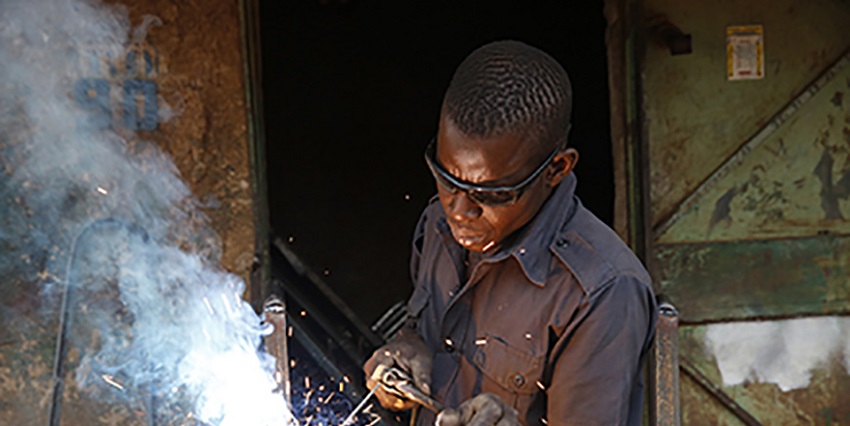By Amélie Riou et Alice Forgeois, Grameen Crédit Agricole Foundation

When we think about microfinance, we think small loans, for people who do not have access to credit, only in the most remote and abandoned areas, granted by small operators managing the outstanding loans of their customers on paper or old computers, only to finance professional activities. In short, nothing very revolutionary or innovative. Do not be fooled! Microfinance continues to evolve and adapt to its environment: better customer relationships and protections, digital services and provision of innovative products for rapidly meeting essential needs. Be ready for a few surprises!
Microfinance and GAFAs *, a possible love affair?
Microfinance is no longer the exclusive domain of NGOs and specialised microfinance institutions. At least, no longer exclusively. Is it for the best…? New market players, internet, mobile, digital giants, are interested in microfinance and offer microcredit products. Easy for them as they know their customers well and can exchange information and money very quickly with them. Here are some examples:
Baidu, the Chinese google, offers microloans through its subsidiary Chongqing Baidu Micro Finance to ride the wave of consumer credit which is growing steadily in China and which represented, as of September 2017, a market of 30.2 billion yuan (3.9 billion euros). Baidu reported using big data, machine-learning techniques and facial recognition technology to help assessing the credit record of potential borrowers. Micro-borrowers repay directly through a “wallet” application and the loan application is submitted online. These loans are often intended to finance studies in private institutions (English training, professional training or IT training).
Simultaneously, last September Amazon announced a partnership with Bank of Baroda (India) to offer microcredit products to sellers on Amazon. Loans at this stage are offered to sellers who fulfill a number of criteria (date of creation of the Amazon account, sales history of the seller, customer returns, seller that complies with Amazon e-commerce rules). Indian sellers will be able to use directly the profits from their sales to repay their loan. Amazon wishes to attract 15 to 20% of Amazon India’s customers in one year…! Be careful, digital can be a channel for the development of microfinance, but could ultimately be a factor of additional financial exclusion, by recording and making available a large amount of information and borrowers’ history…
Microfinance and macro-services?
Green microfinance, micro-nutrition, agricultural insurance … No link between these different topics a priori? Indeed, there is a link. These products have now become an integral part of microfinance institution activities and complement the offer of traditional credit. Forget the classic pattern and welcome in the 2.0 microfinance! Thanks to the geographical diversity of MFIs, the proximity they have with each client and their strong rural roots, microfinance is becoming a privileged channel for the distribution of new services.
A team of researchers recently asked whether it was possible to use the network of MFIs to combat malnutrition, which is almost always linked to poverty in developing countries. The team thus made available to the institutions micronutrients containing 15 essential vitamins and minerals and then measured the impact of this distribution by taking blood samples. Following this study, this distribution network appeared to be very effective in the fight against malnutrition. To consolidate the results, a study will be conducted throughout Haiti. Interesting prospects are in sight!
Very little widespread in Africa but with huge potential developments, agricultural microinsurance offers small producers the opportunity to insure their harvest against various risks (weather conditions, diseases, etc.). How to democratise access to microinsurance? Precisely, thanks to microfinance: the insurance product can be offered to the client, together with a microcredit.
The supply of credit products has also grown considerably over the past years: specific microcredits to facilitate access to renewable energy, decent housing, etc. An increasingly wide range of products that make it possible to better cover the needs of the communities, on levels as different as necessary.
Is microfinance heading towards new horizons?
Historically intended for developing countries, microfinance is also present in Europe.
Why? It is presented as one of the possible answers to the economic crisis, social unrest or financial exclusion and is supported by the States. Who? Thanks in particular to non-bank financial institutions and NGOs. Who is it for? According to the Convergences 8th Microfinance Barometer, the outstanding microcredit gross portfolio in Europe amounts to 2.5 billion euros, of which 71% is intended for professional purposes for people who have a limited access to financial resources. How? The terms and conditions of these loans vary widely from one European State to another: from 3% in Poland, Finland and France to 28% in Serbia, with average loans per borrower ranging from around 100 euros to 25,000 euros. In addition to microcredit, these European microfinance institutions are increasingly offering additional services, such as savings, insurance, etc.
In addition to expanding to new countries, microfinance is adapting to countries in which it has already been present for many years: Islamic microfinance is developing. Why? In order to satisfy potential beneficiaries who do not use traditional microfinance because of their religious beliefs. How? By adapting the traditional microfinance scheme to commercialise Sharia-compliant products, mainly by withdrawing the concept of interest rates from products on offer. What prospects? Still in a minority compared to the entire sector, the market is growing rapidly in many countries. The three pioneering countries of Islamic microfinance are Indonesia, Lebanon and Bangladesh but the model should expand to improve the financial inclusion of all. What impact? The scope of this new type of microfinance is very important in Muslim countries with around 56% of Moroccans who refuse to use microfinance services for religious reasons.
* Acronym for the four US giants of fixed and mobile Internet, Google, Apple, Facebook and Amazon
_________________________________________________